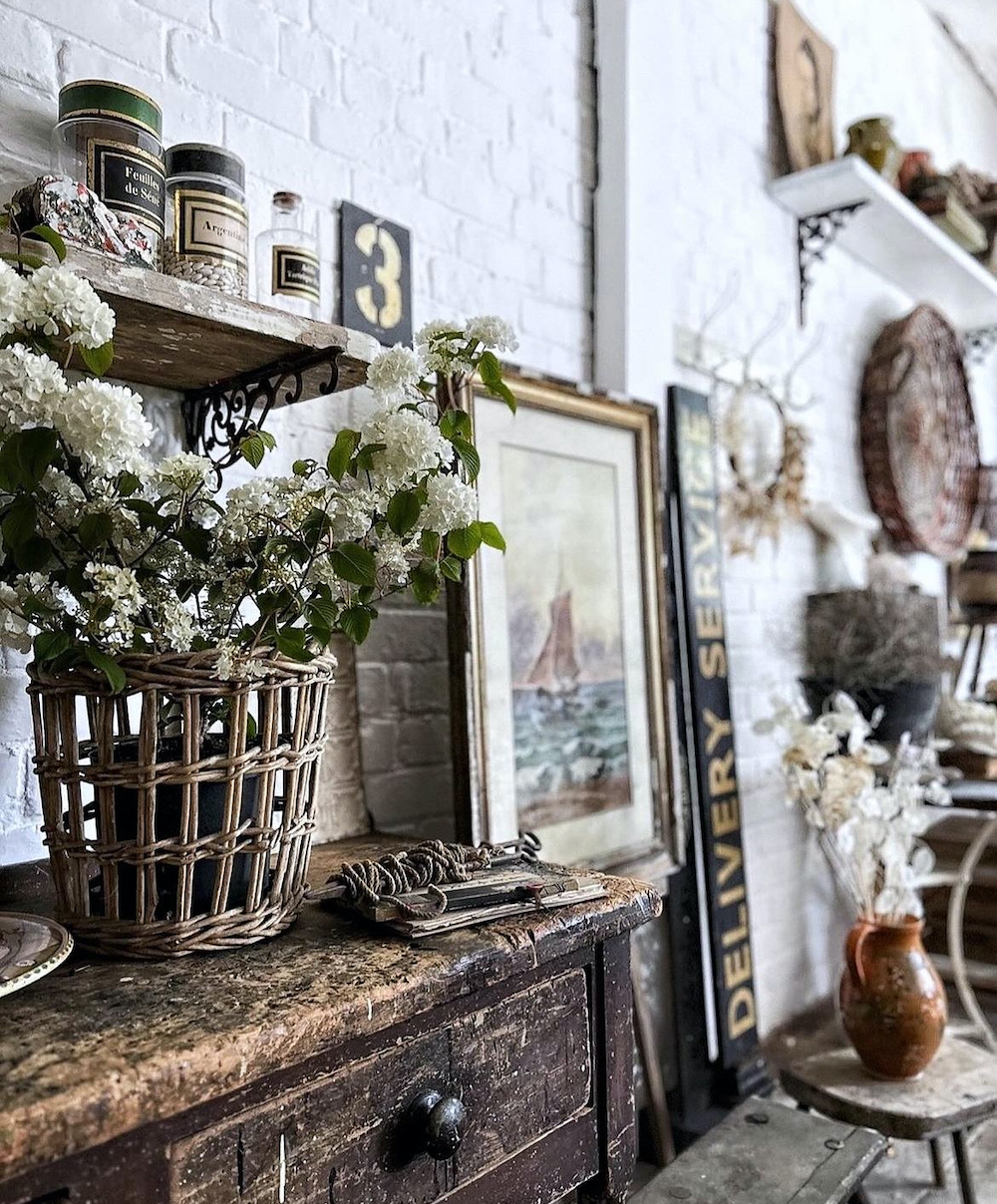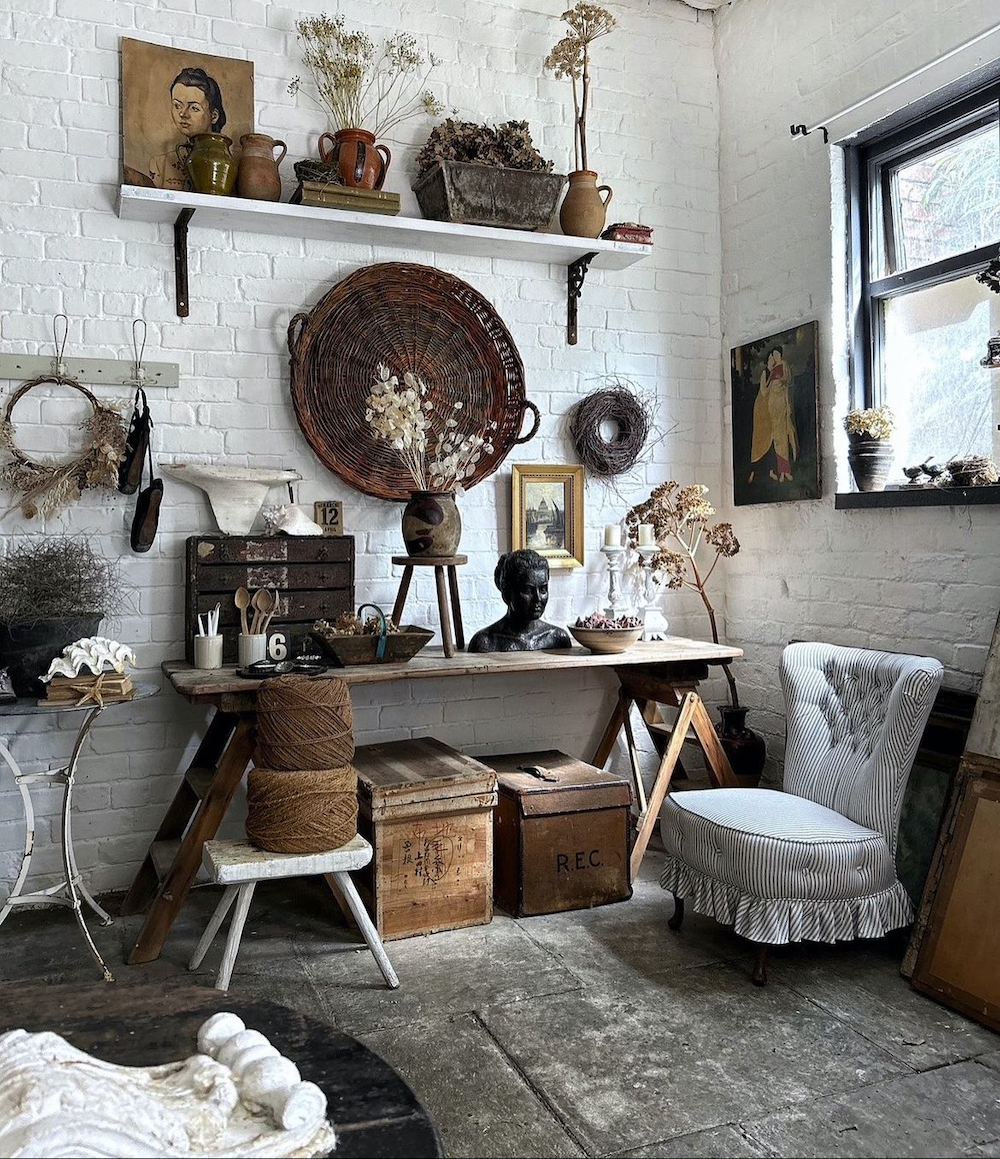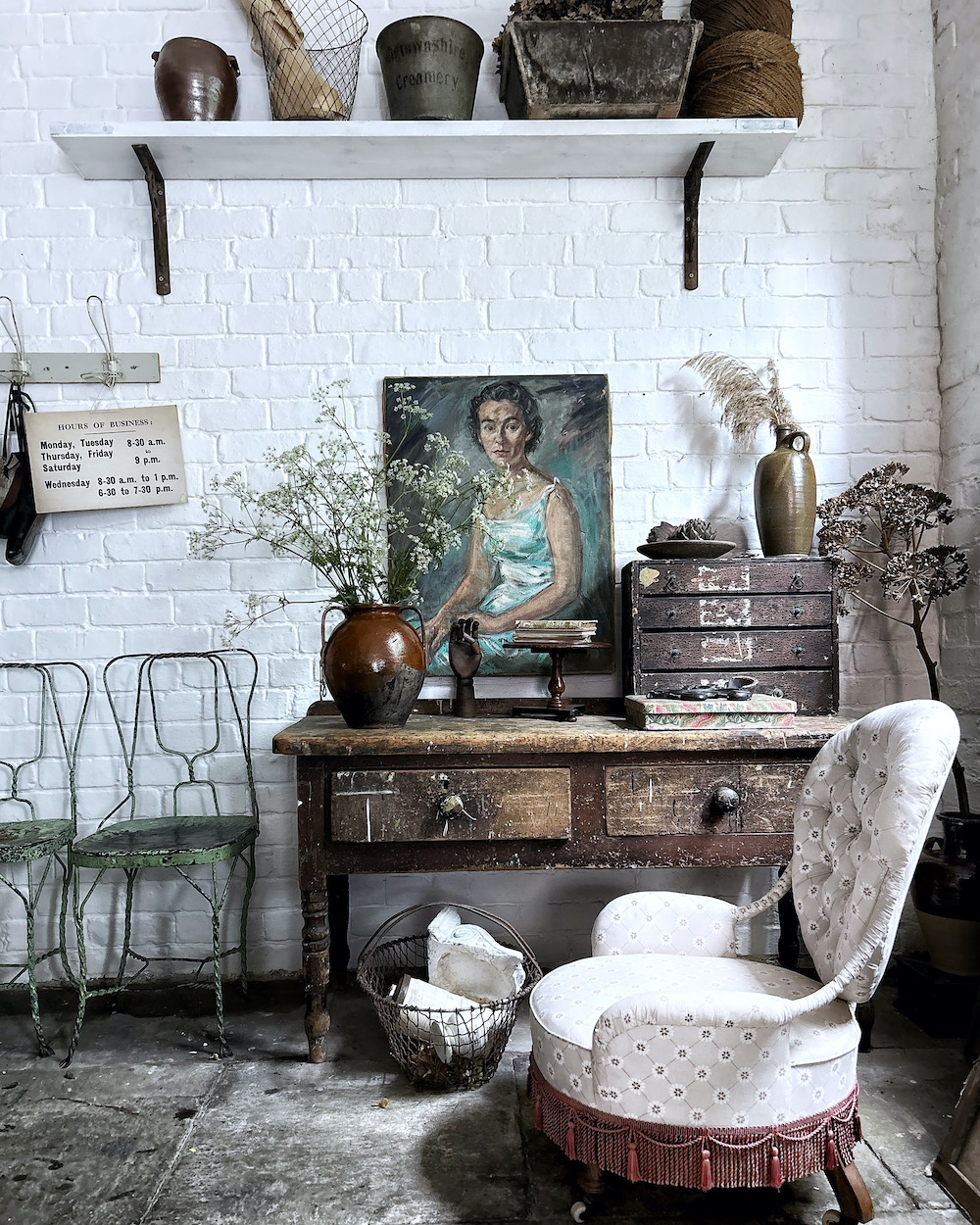Antiques Trade Talks – The Old Potato Store
 Karen Barlow, who trained and qualified as an interior designer and stylist, started running her online business, The Old Potato Store, almost six years ago after she and a friend bought a Victorian, stone-floored building in Urmston, Manchester. Built in 1901, Karens says, “I use only natural light for my photography and with the painted brick work and reclaimed wooden-clad walls I’ve had installed, it makes the perfect backdrop for the shots I like to create.” Eventually she hopes to open the premises to the public for selling and pop-up events, however until then find her at www.theoldpotatostore.co.uk and on Instagram @theoldpotatostore.
Karen Barlow, who trained and qualified as an interior designer and stylist, started running her online business, The Old Potato Store, almost six years ago after she and a friend bought a Victorian, stone-floored building in Urmston, Manchester. Built in 1901, Karens says, “I use only natural light for my photography and with the painted brick work and reclaimed wooden-clad walls I’ve had installed, it makes the perfect backdrop for the shots I like to create.” Eventually she hopes to open the premises to the public for selling and pop-up events, however until then find her at www.theoldpotatostore.co.uk and on Instagram @theoldpotatostore.
How did you get started in antiques and vintage?
This isn’t my first foray into selling antiques and vintage. When my children were little, over 20 years ago, I sold vintage clothes and textiles and pieces of antique furniture. I had a concession called Perry Green at a shop in Manchester. I sold to a lot of commercial customers including Selfridges for their displays, Elle decoration and Martha Stewart home. My parents bought and sold antiques when I was a child and I used to go with them to antique fairs with my pocket money and buy old jewellery which I collected. Nothing of value, although it did train me to have a magpie’s eye for the decorative pieces that I now sell.
Tell us about your career path?
My background from leaving school was in finance and I worked as an underwriter for many years for an insurance company, although I was always a frustrated creative. After having my two children, I took a few years off to bring them up and then went back to university to study for a BA in interior design, before going on to work as an art director and stylist for many of the UK’s largest high street homewares brands, which I’ve done for almost 17 years now.
My training in interior design and my work collating mood boards and designing sets for shoots and TV commercials, definitely informs my choices when buying for my business. I have to have an understanding of different periods of design and need to be on top of trends for designs and colours and working with so many professional photographers has certainly helped me to become a much better photographer and understand composition when looking through a camera lens. I think because of my background, customers trust my style choices and a lot of my customers are stylists, visual merchandisers and interior designers themselves who are working on client projects or for second-home owners, so they come to me to find the items they are looking to source.

What is the unique appeal of antiques?
The obvious appeal of antiques and vintage is the sustainability of the pieces. Although this appeal has now reached a wider audience it was always the way I preferred to shop ever since buying my first property in 1989. I’ve always loved the individuality that an old piece can bring to an interior. You’re never going to get a cookie-cutter-look home when you furnish it using a mix of antiques and vintage pieces.
What’s currently in demand?
I have always sold lots of art from the very start of my business, including paintings, vintage prints and photography. It’s a personal passion and interest of mine and I’ve spent all my adult life visiting art galleries and museums all over the world. Since starting my business I have seen the popularity of styles of art change. A few years ago there was a demand for portrait oil paintings and early 20th Century still-life floral paintings, now there’s a real interest in mid-20th century cubist and abstract or expressionist art.
I really enjoy following some of the dealers that sell items from the later part of the 20th Century. Lots of rattan and studio pottery, as well as a really interesting mix of mid century items from Europe. Some favourites include: Folie Chambre, Tat London, AOE Objects, and Old Old Woods. And I particularly like the stock that Howard at Societique in Morecambe sells and his style of photography.
What antiques do you have in your home?
I think the antiques of the future will be anything well made, from sustainable materials and by artisans. Items from companies such as Pinch or Benchmark or small batch pottery. I also think there is and will continue to be a desire for smaller more versatile pieces of furniture as rental properties become more popular and homes are generally getting smaller. I live in Manchester and there are so many new apartment blocks within the city centre which just can’t accommodate larger pieces of furniture.

How is the industry changing and are you optimistic for its future?
I’m very optimistic for the continuation and growth of the antiques industry which creates a circular economy. Consumers are much more interested in the lifespan and durability of a product, how far it’s travelled and what it’s been made of and where. Antiques are the ultimate sustainable products.
Is new technology good for the trade and buyers/collectors?
Technology has made a huge change to how and where antiques are bought and sold. Before the pandemic and lockdown a lot of dealers weren’t online or on social media and there was an air of secrecy between dealers about their stock and prices. This all changed with the pandemic and everything is now much more transparent and accessible. Both buyers and dealers can now shop online or through Instagram anywhere in the world, at any time of the day or night and it’s very exciting.
Social media has also meant that buyers can form close relationships with dealers and check their new stock as it’s uploaded and request them to look for particular items for them. When I dealt in vintage clothes and textiles over 20 years ago, I could never have dreamt of expanding my client base and relationships with my customers like I have through Instagram.
Tell us some trade secrets?
Some of my trade secrets which aren’t really secrets but just good to knows are to always get to an antique fair earlier than the advertised time to beat the queues, take more cash than you think you’ll need as you never know what you’ll find, take a festival trolley for your purchases and a blanket to protect more delicate buys. Build relationships with favourite dealers and get their business card or phone number. The amount of times I’ve walked away from an item and then changed my mind when I’ve been half way home!
What antiques/artworks would you buy if money were no object?
If money were no object I’d love a piece of work by Duncan Grant of the Bloomsbury group of artists. I recently saw a hand-painted lampshade at an auction house which went for thousands! I’d also love a classic vintage George Smith sofa. I love traditional classic design in the main. Pieces that will never date and I’ll always love.
You’re down to your last 50 quid – what antiques/art would you buy?
If I was down to my last £50 I’d probably buy a pretty hand-painted French jug in the Quimper style or some hand-painted plates, or a shell-covered antique jewellery box or photo frame. I’m always drawn to decorative antiques, with my interior design background, so aesthetics are always more appealing to me than value.
Alongside fairs, where are your favourite antique hunting destinations and why?
I love trawling auction houses both online and if I can get to a preview of the auction in person I will. You can always see the condition of a piece so much better than the auction houses photos online and quite often there is more than one item within a lot and you can get some real bargains.
What are some of the biggest mistakes that buyers make – what questions should they ask?
Some of the biggest mistakes I’ve made are not checking the dimensions of a piece correctly when buying online. Also check wooden items all over for active woodworm and metal objects for rust that has damaged the item. The reason I mentioned taking a blanket to the fairs to protect items is because I am that person who has put a canvas painting into my trolley for the bolt on the side of the trolley to go right through it!

Any styling advice for using antiques in the home?
Styling advice from a stylist? Where do you want me to stop? First and foremost I would always use texture within an interior scheme. So a mixture of wood with a lovely patina, metal wire work, natural European linen for cushions and lampshades, which can be bought in abundance from the International antique fairs.
Tactile finishes that will age gracefully will always look good. Also layer objects. Artwork on mantlepieces and shelves with smaller prints or postcards in front, little object d’art on top of a pile of old books, placing objects on top of a plaster of Paris mould or little decorative wooden trays.
Hang rustic baskets from the kitchen ceiling and old bread boards from hooks on the wall. If you’re using a mixture of eras and styles try and keep to a similar tonal colour palette. I could go on but I won’t. If you want to know more I have an online course, available on my website, that I wrote with my friend, photographer Roberta Ashley, combining our experience of photography and styling for small businesses. It’s a wealth of information!
What do you consider the high point of your career in antiques?
I’ve had many high points over the six years I’ve been running my business, including some of my images appearing in national newspapers, books and publications, but my most exciting experience to date was being asked to appear as a guest on one of my favourite podcasts Country & Townhouse magazine’s ‘House Guest’ – I still can’t believe I got the call from Carole Annett the host.
Are antiques attracting younger buyers and, if not, how can the industry reach out to them?
Antiques are most definitely attracting younger buyers which is most evident when I visit Sunbury antiques fair at Kempton Race course near London, which is such an eclectic event. They have a much younger aesthetic and are looking for items that many may not consider as traditional antiques. So items from the 1980s and even the 90s. Designs from that era from Ikea and Habitat are very collectable and they mix them up with older period paintings and chintzy furniture and lots of colourful objects.
What advice would you give to people new to antiques who want to learn more?
If you are just starting to think about becoming an antique dealer, I would say start with what you love as a specialism. Learn more about it and ask lots of questions from dealers, read lots of books, go to museums such as the V&A and The Design museum and if it’s art you’re interested in go to lots of art galleries and educate your eye as to what is good and bad design or art. Go to auctions as a voyeur at first and see what sells and for how much and what pieces garner the most interest. Speak to the auctioneer if you can or the staff, at the preview before the auction, and ask about pieces that interest you. They will have the knowledge and the piece will have the provenance.

